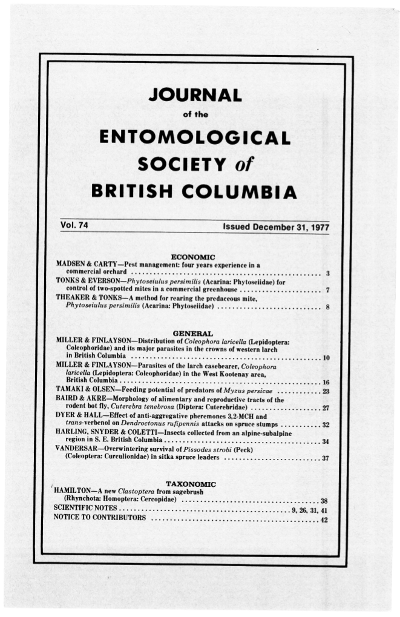A method for rearing the predaceous mite, <i>Phytoseilus persimilis</i> (Acarina: Phytoseiidae)
Keywords:
<i>Phytoseilus persimilis</i>, Acarina, PhytoseiidaeAbstract
The predaceous mite, <i>Phytoseiulus persimilis</i> Athias-Henriot, was reared successfully in a darkened growth chamber on blotting paper on a freezer carton lid floated on water in a plastic saucer. Predators were fed with two-spotted spider mites collected from infested bean leaves with a mite brushing machine.References
Anonymous. 1975. Biological pest control - rearing parasites and predators. Bull. No.2. Glasshouse Crops Research Institute, Littlehampton, Sussex.
Henderson, C.F. and H.Y. McBurnie. 1943. Sampling techniques for determining populations of citrus red mite and its predators. U.S. Dep. Agric. Circ. 671.
McMurtry, J.A. and G.T. Scriven. 1965. Insectary production of Phytoseiid mites. J. Econ. Ent. 58:282-284.
Scopes, N.E.A. 1968. Mass rearing of Phytoseiulus riegeli Dosse for use in commercial horticulture. Pl. Path. 17:123- 126.
Scriven, G.T. and J.A. McMurtry. 1971. Quantitive production and processing of Tetranychid mites for large-scale testing or predator production. J. Econ. Ent. 64:1255-1257.
Downloads
Published
Issue
Section
License
Authors who publish with the Journal of the Entomological Society of British Columbia agree to the following terms:
-Authors retain copyright and grant the journal right of first publication with the work simultaneously licensed under a Creative Commons Attribution License that allows others to share the work with an acknowledgement of the work's authorship and initial publication in this journal.
-Authors are able to enter into separate, additional contractual arrangements for the non-exclusive distribution of the journal's published version of the work (e.g., post it to an institutional repository or publish it in a book), with an acknowledgement of its initial publication in this journal.
-Authors are permitted and encouraged to post their work online (e.g., in institutional repositories or on their website) prior to and during the submission process, as it can lead to productive exchanges, as well as earlier and greater citation of published work (See The Effect of Open Access).


